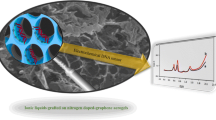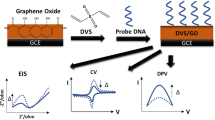Abstract
Herein, we present the electrochemical co-deposition of Al3+/graphene composites directly from an aqueous mixture containing graphene oxide (GO) and Al3+. The obtained Al3+/graphene composites with good electrochemical activity were regarded as an appropriate immobilization platform for double-stranded DNA (dsDNA). The nontoxic redox probe xanthurenic acid (XA) was successfully applied to recognize single-stranded DNA and dsDNA. We illustrated that the scission of dsDNA caused by GO combining with some metal ions could be detected by monitoring the electrochemical signals of XA.
Similar content being viewed by others

References
Novoselov KS, Geim AK, Morozov SV, Jiang D, Zhang Y, Dubonos SV, Grigorieva IV, Firsov AA. Electric field effect in atomically thin carbon films. Science, 2004, 306:666–669
Wang T, Zhu Y, Li G, Zhang SY, Song JM, Mao CJ, Wu JY, Jin BK, Tian YP. A novel hydrogen peroxide biosensor based on the BPT/AuNPs/graphene/HRP composite. Sci China Chem, 2011, 54:1645–1650
Du M, Yang T, Li X, Jiao K. Fabrication of DNA/graphene/polyaniline nanocomplex for label-free voltammetric detection of DNA hybridization. Talanta, 2012, 88:439–444
Du M, Yang T, Zhao CZ, Jiao K. Electrochemical logic aptasensor based on graphene. Sensor Actuat B Chem, 2012, 169:255–260
Yang T, Li QH, Li X, Wang XH, Du M, Jiao K. Freely switchable impedimetric detection of target gene sequence based on synergistic effect of ERGNO/PANI nanocomposites. Biosens Bioelectron, 2013, 42:415–418
Du M, Yang T, Guo XH, Zhong L, Jiao K. Electrochemical synthesis of Fe2O3 on graphene matrix for indicator-free impedimetric aptasensing. Talanta, 2013, 105:229–234
Yang T, Li X, Li QH, Guo XH, Guan Q, Jiao K. Electrochemically reduced graphene oxide-enhanced electropolymerization of poly-xanthurenic acid for direct, “signal-on” and high sensitive impedimetric sensing of DNA. Polym Chem, 2013, 4:1228–1234
Liu M, Zhao HM, Chen S, Yu HT, Quan X. Capture of double-stranded DNA in stacked-graphene: giving new insight into the graphene/DNA interaction. Chem Commun, 2012, 48:564–566
Niu SY, Zhao M, Ren R, Zhang SS. Carbon nanotube-enhanced DNA biosensor for DNA hybridization detection using manganese (II)-Schiff base complex as hybridization indicator. J Inorg Biochem, 2009, 103:43–49
Erdem A, Kerman K, Meric B, Ozsoz M. Methylene blue as a novel electrochemical hybridization indicator. Electroanal, 2001, 13:219–223
Sturney RG, Wild CP, Hardie LJ. Removal of red light minimizes methylene blue-stimulated DNA damage in oesophageal cells: implications for chromoendoscopy. Mutagenesis, 2009, 24:253–258
Shen L, Ji HF. Theoretical exploration of the photosensitive properties of xanthurenic acid, a tryptophan metabolite in cataractous human lenses. Dyes Pigments, 2008, 76:646–649
Zhang W, Yang T, Jiao K. Ultrasensitive indicator-free and enhanced self-signal nanohybrid DNA sensing platform based on electrochemically grown poly-xanthurenic acid/Fe2O3 membranes. Biosens Bioelectron, 2013, 31:182–189
Kovtyukhova NI, Ollivier PJ, Martin BR, Mallouk TE, Chizhik SA, Buzaneva EV, Gorchinskiy AD. Layer-by-layer assembly of ultrathin composite films from micron-sized graphite oxide sheets and polycations. Chem Mater, 1999, 11:771–778
Wang G, Yang J, Park J, Gou X, Wang B, Liu H, Yao J. Facile synthesis and characterization of graphene nanosheets. J Phys Chem C, 2008, 112:8192–8195
Duskova K, Sierra S, Fernandez MJ, Gude L, Lorente A. Synthesis and DNA interaction of ethylenediamine platinum(II) complexes linked to DNA intercalants. Bioorgan Med Chem, 2012, 20:7112–7118
Wong EL, Gooding JJ. Electronic detection of target nucleic acids by a 2,6-disulfonic acid anthraquinone intercalator. Anal Chem, 2003, 75:3845–3852
Wong EL, Gooding JJ. Charge transfer through DNA: A selective electrochemical DNA biosensor. Anal Chem, 2006, 78:2138–2144
Wang ZJ, Zhang J, Yin ZY, Wu SX, Mandler D, Zhang H. Fabrication of nanoelectrode ensembles by electrodepositon of Au nanoparticles on single-layer graphene oxide sheets. Nanoscale, 2012, 4:2728–2733
Mancin F, Scrimin P, Tecilla P, Tonellato U. Artificial metallonucleases. Chem Commun, 2005, 2540–2548
Biver T, Secco F, Venturini M. Mechanistic aspects of the interaction of intercalating metal complexes with nucleic acids. Coord Chem Rev, 2008, 252:1163–1177
Friedman AE, Chambron JC, Sauvage JP, Turro NJ, Barton JK. Molecular light switch for DNA: Ru(bpy)2(dppz)2+. J Am Chem Soc, 1990, 112:4960–4962
Sheng X, Lu XM, Chen YT, Lu GY, Zhang JJ, Shao Y, Liu F, Xu Q. Synthesis, DNA-binding, cleavage, and cytotoxic activity of new 1,7-dioxa-4,10-diazacyclododecane artificial receptors containing bisguanidinoethyl or diaminoethyl double side arms. Chem Eur J, 2007, 13:9703–9712
Camargo MA, Neves A, Bortoluzzi AJ, Szpoganicz B, Fischer FL, Terenzi H, Serra OA, Santos VG, Vaz BG, Eberlin MN. Efficient phosphodiester hydrolysis by luminescent terbium (III) and europium (III) Complexes. Inorg Chem, 2010, 49:6013–6025
Pitie M, Pratviel GV. Activation of DNA carbon-hydrogen bonds by metal complexes. Chem Rev, 2010, 110:1018–1059
Author information
Authors and Affiliations
Corresponding author
Electronic supplementary material
Rights and permissions
About this article
Cite this article
Du, M., Kong, Q., Yang, T. et al. Al3+/graphene composites for electrochemical detection of DNA cleavage. Sci. China Chem. 56, 1325–1330 (2013). https://doi.org/10.1007/s11426-013-4858-0
Received:
Accepted:
Published:
Issue Date:
DOI: https://doi.org/10.1007/s11426-013-4858-0



